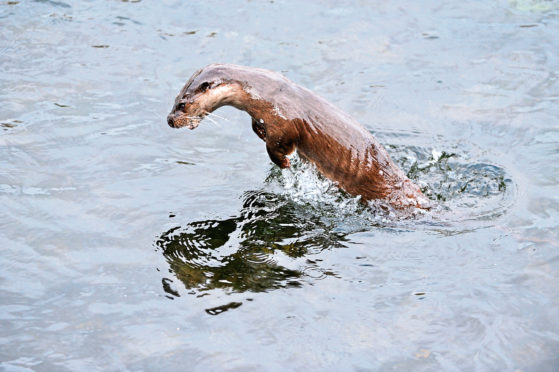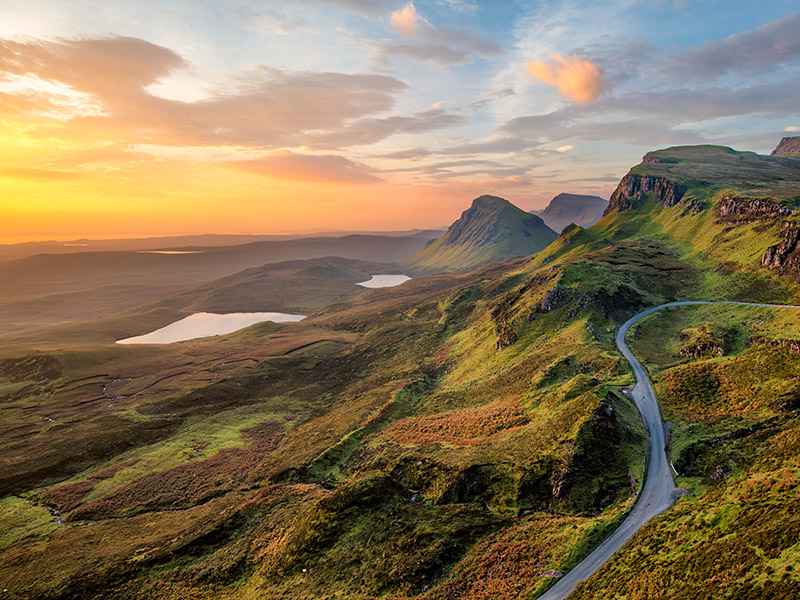
Skye in my mind has always been eagles and otters. There is a particular loch that springs to mind, unsung, unloved, and as yet untroubled by overtourism.
South Skye’s Atlantic coast is wilder here than anywhere else. From above, the loch appears to lie nowhere at all, as if it had been disowned by its landscape. The glen it inhabits is barely worth the name. Its Gaelic name just means “in the middle”. In truth, the middle of nowhere is where and what it is.
This is not tourist Skye, not Speed Bonnie Boat Skye. No Bonnie Prince ever skulked here.
The burn that flows from the loch a little over a mile to the ocean has a name even less riveting than the glen – it means “the burn of the glen”. There is a cnoc a little to the north, a lumpen hillock, one of hundreds that throng this rumpled sprawl of land, a tranquil upheaval of rock and peat and lochs and lochans and muttering burns. And eagles. And otters.
The cnoc is nameless, but its view encompasses the loch, the length of the burn, a generous swathe of Sleat, the headland of Strathaird, Soay, the overlordship of the Cuillin, aloof Rum with a tilted skullcap of clouds.
There was an otter on the burn. For the past hour it had been fishing leisurely on the loch.
“Leisurely” is the otter-watcher’s spin on what had unfolded as it made fishing look so effortless. The demeanour was unhurried, confident. Litheness as an art form. It hardly ever seemed to miss.
It surfaced, ate on its back from the fish in its “hands”, the fish dying bit by bit. It rarely seemed to be fully consumed before the otter dived again, tail following torso down like an obedient eel. The process was repeated and repeated with the same rate of success.
Before the otter turned up, the loch was a sheet of uncreased silk, or a dish of pale blue milk. Nothing moved. No hint of wind disturbed the utter calm. A golden eagle appeared in the sky from nowhere. It was just suddenly there in the middle of the sky and I never saw it arrive. How do they do that?
Then it began to climb in slow circles, sunwise. It climbed and climbed until even binoculars couldn’t hold on to it. Four thousand feet? Five? It vanished simply by climbing beyond the possibilities of human sight.
Then the otter. I found it because the loch spoke.
“Plop!” it said and I looked towards the sound and a V-shaped wake had begun to spread across the surface, except that it didn’t quite meet at the point of the “V”. Instead of a point there was a blunt curve, and there was the head of the otter. The loch surface started to tremble and separate into bands of blue and white as the wake spread. The otter heaved up and out of the water, a steep diagonal that only curved forward at the neck, the head tilting down.
The whole thing appeared to hold steady for a fraction of a moment in a perfectly balanced curve. Then it unfurled, the tail almost vertical as it began to sink, almost no splash, just a second “plop!” and the water shuddered then slowly eased down to a complete standstill.
The eagle had appeared in the middle of the sky and vanished going straight up. The otter had appeared in the middle of the loch and vanished going straight down. The advantage of height as it dived gave me a momentary glimpse into the transformation from surface-swimming otter to underwater otter, the steeply-angled surge of acceleration into blackness.
Perhaps it missed this time for when I saw the otter again about five minutes later it was running along the far shore towards the outflow. It had become a hunchbacked land weasel with an awkward bouncing gait, all litheness abandoned.
It reached the outflow of the burn, where it paused, lifted its tail and deposited a spraint. Spraints are otter-to-otter conversation. They convey messages held together with fish bones.
Then the otter took to the burn, and was now an animal in travelling mode. Its journey downstream was fluent and funny – fluent where it swam in the mainstream, urged on by the current, funny where it ran and splashed through the shallows. Fishing was suddenly off the menu. Now the journey was all-consuming.
I wondered how it visualised its territory. Was the burn a part of it? The loch? Or was the territory a mile or two of ocean shoreline, and the burn and the loch just an occasional option?
I like to be reminded now and again that nature keeps many of its secrets to itself and shares them only with those creatures that need to know. I am an occasional visitor to this shore, so I don’t expect to know as much as I do in the places I go week after week in every season of the year.
The otter was last seen heading for the ocean. Late afternoon, nudging towards evening. I had sat another hour, enjoying the view, renewing bonds with Skye that reach back 50 years.
Stillness in the landscape is how I work best, letting nature come to me, bearing secrets. And when I said that Skye in my mind has always been golden eagles and otters, that wasn’t quite the whole truth. And I had half-expected to see both when I walked this middle-of-nowhere glen with its aloof loch. I had settled down on the cnoc so that I could see loch and burn and ocean and mountains and near and far islands, but what I was really hoping for was a flypast of whooper swans, fresh from Iceland and flying down the Minch and drifting towards this Sleat shore.
I know of old that this loch is to the swans’ liking. If they have spent the day feeding here and there around Sleat, they may roost here. If they have flown down the northern ocean and are about to make landfall, they may use the loch as a staging post.
Their voices reached me first. They are simply the sound that I love best in all nature. I put the glasses on the ocean and I found them heading east at wavetop level. They call in soft notes of muted brass that make me think of Icelandic glaciers. Of north. They homed in on the burn, an arrowhead of nine birds, they reached the loch flying 50 feet below me. Their voices echoed among rocks. That sight, that sound…these are sacred moments.
The loch paled in the last of the light to almost white. As the swans flew across it they darkened against such a background to purplish gray. They landed far up the loch and immediately their voices became loud and exultant, their wings threshed the air, they gathered in an inward-facing arc, for the need to mark journey’s end with a kind of exuberant gratitude is a communal one, whether the journey has been a few miles or a thousand.
The whole truth is that Skye in my mind has always been golden eagles and otters…and whooper swans.

Enjoy the convenience of having The Sunday Post delivered as a digital ePaper straight to your smartphone, tablet or computer.
Subscribe for only £5.49 a month and enjoy all the benefits of the printed paper as a digital replica.
Subscribe © Shutterstock
© Shutterstock